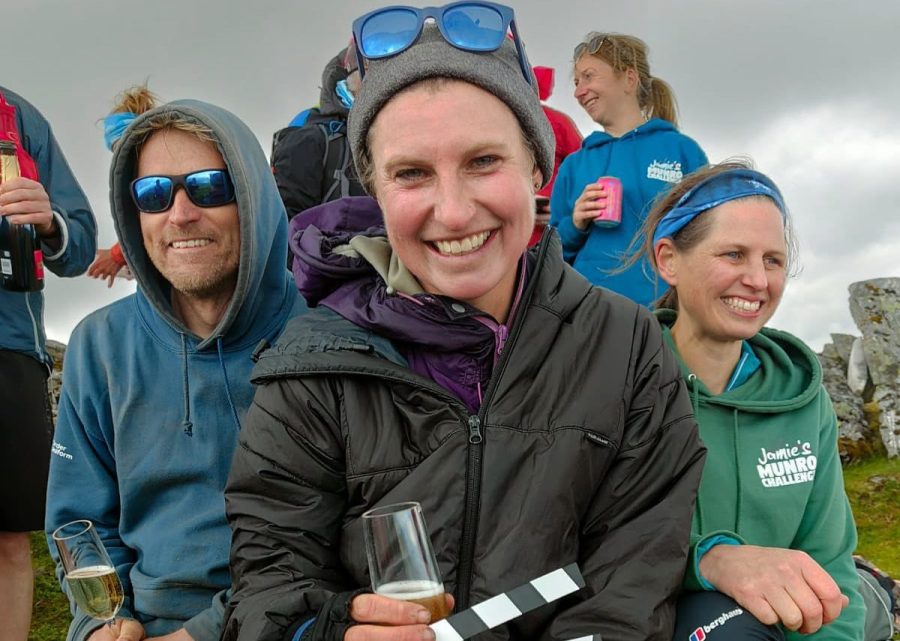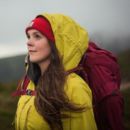Jamie Aarons, a 43-year-old self-confessed California Girl and endurance athlete has ‘compleated’ her third Munro round since moving to Scotland in 2005 on June 26th 2023. They do say the third time is a charm. On this self-propelled continuous round, Jamie summited all 282 Scottish mountains in just 31 days 10 hours 27 minutes, besting Donnie Campbell’s previous record by 12 hours. In doing so, Jamie had hoped to raise £6,000 for World Bicycle Relief, a charity committed to helping individuals overcome the barrier of distance to education, healthcare and livelihood and give independence through bicycles. Her fundraising total has since exceeded £20,000 at the time of writing.
On Jamie’s Munro Challenge, which took two years to plan, she covered a momentous 2576.52km including 135,366m of ascent, 1315km on foot, 830km by road bike, 370km by mountain bike, 49km on her gravel bike and 11.6km by kayak. She climbed the equivalent of Mount Everest 16 times, climbing 14 Munros in a single, gruelling day. Jamie slept an average of four hours a day. Her shortest sleep was what she calls a ‘micro-nap’ of just 60 seconds.
But, Jamie didn’t achieve this feat of physical and mental endurance just for the stats or to break a record. She chatted with The Great Outdoors on her first Monday away from the mountains and back to reality about how much the community of 117 volunteers meant to her during the metaphorical – and literal – highs and lows of her record-breaking round. We also talk race mantras, foot injuries, cutting sleep, sundogs and strawberry moons, and why Jamie thinks her record will be broken sooner rather than later.
TGO: Hi, Jamie! Congratulations. I suppose this Monday is looking very different to your last few – if you were even aware of Monday’s as a concept during your round?
Jamie Aarons: Everyone’s expectations of me at work right now are rightly quite low!
I was aware of days of the week on the round – my support team kept me clued in – but I admit work has been quite far from my mind over the last month!
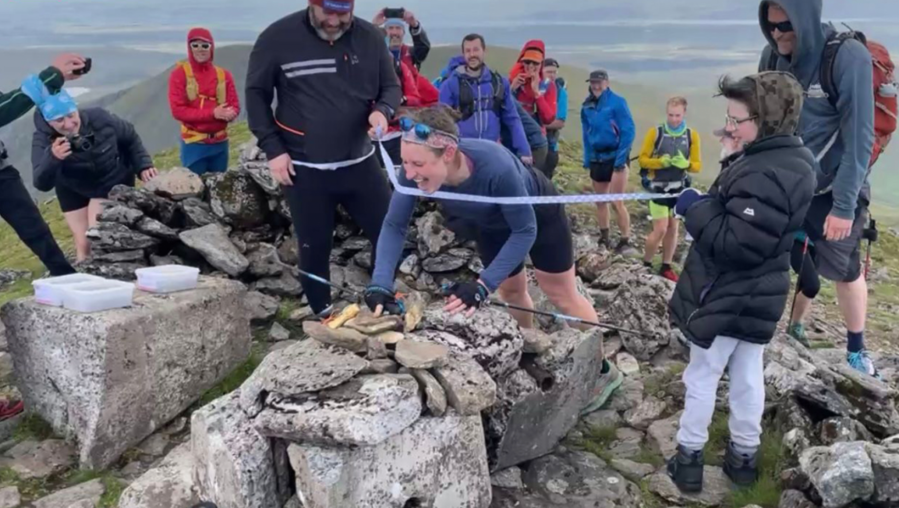
The exact moment Jamie Aarons broke the record for a self-propelled Munro round. Credit: Jamie’s Munro Challenge.
TGO: You may be more intimately familiar with the Munros than many, now, but what drew you initially to Scotland?
Jamie Aarons: We first moved in 2005. My partner, Andy is English and a keen ice climber with fond memories of the Highlands. At the time, I was a social worker in the States but had always wanted to practice outside of the US and learn about social policy of other countries. We stayed for the access laws and opportunities we’ve been afforded by those. We started out as hillwalkers, climbers, mountaineers but, here in Scotland we’ve been able to expand. Mountain biking and sea-kayaking – the west of Scotland is renowned for paddling – has certainly contributed to us having lived here for nearly 20 years now!
TGO: You’ve had great success with ultra running in your home country and here in the UK. How did these past race experiences prepare you?
Jamie Aarons: Growing up I was a competitive swimmer. Actually, I would still consider myself more of a swimmer than anything even though I’ve not been in a pool for so long. When I turned 30 and living in New York I ran the New York marathon but, even then, I would’ve in no way associated myself with the running identity. It was only upon moving to Scotland that I was introduced to trail running. Along with the self-sufficiency and navigation – not just in an orienteering sense but also being able to make my way in the wilderness – being able to marry those passions ultimately led me to this Munro round. But even so, it included very little in the way of running!
TGO: Why was that?
Jamie Aarons: I was preserving my legs for the last four or five days, intending to run more of the descents and flat but my left foot had other ideas. A nerve had been aggravated from the repeated pounding for a month without much recovery each night. It was just getting worse and worse. I’d also had infected unpopped blisters. Luckily those had been dealt with by a medic who was kind enough to treat me in the middle of the night at a transition. I was in quite a lot of pain. In the last few days I wasn’t able to run at all – even the terrain that was really runnable – which was quite disappointing even for someone of my caliber of running. I’m a plodder!
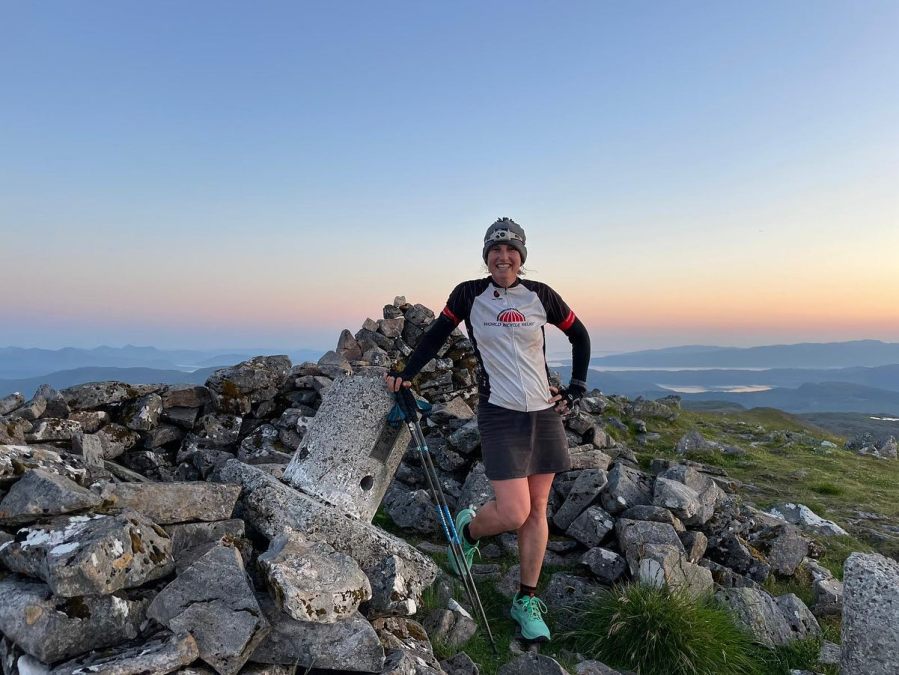
“I wanted to see how far I could get on my own steam.” – Jamie Aarons. Credit: Jamie’s Munro Challenge
Otherwise, I had no running-related injuries because I wasn’t really running! Throughout I was incredibly risk adverse and taking it way more cautiously than I usually would, recognising that something really silly like a trip or fall could be catastrophic. If I’m being completely honest, I thought I could’ve done it faster than I did but having ‘compleated’ uninjured and create the community that we did, I know I shouldn’t be anything other than proud.
I’m very confident the record will be broken and I think it will be broken sooner rather than later by someone who is a runner and much faster than I am. But I hope our legacy will be the team and the community. For me, that is certainly what I’m most proud of over the last month.
TGO: You were inspired to take on the round by your predecessor, Donnie Campbell. To what extent did you stick to his round?
Jamie Aarons: I’d heard Donnie interviewed on a podcast that planted the seed of an idea to do the self-propelled round. I got in touch with him early on – before I’d mentioned to many other people that I was even considering it. He was very encouraging and generous. He provided an overview of the hills he did by day in a broad itinerary. As I delved into the detail of my planning I did get back in touch with him with some very specific questions – the phone number of an estate for access, for example.
But I was conscious of not putting him in a difficult position by asking him for more. He’s such a nice person and, more importantly, I was keen to make this route our own using the information he kindly provided and what was in the public domain. We certainly weren’t starting route planning from scratch thanks to his generosity.
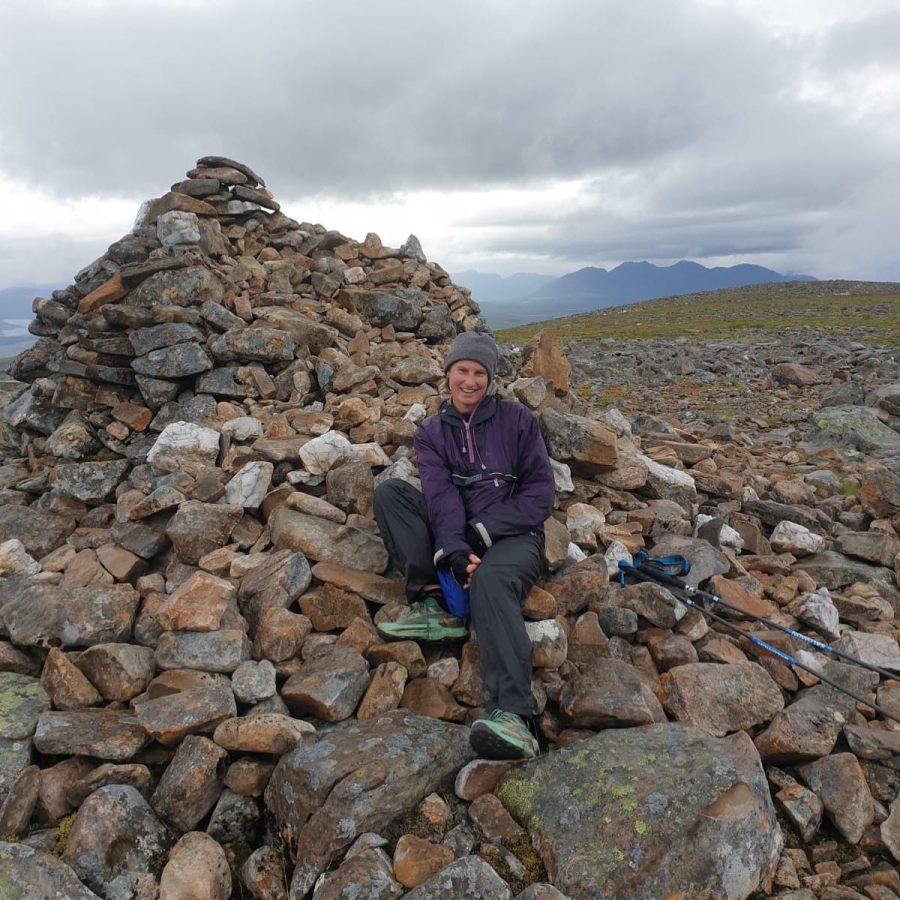
Jamie taking a rest at Beinn Dearg’s cairn. Credit: Jamie’s Munro Challenge.
When Donnie joined us at the end on Beinn Dearg, it was a lovely surprise – I hadn’t been expecting to see him. His wife and dog were out there with us, too! He’s had a broken collar bone in the not too distant past but, by this point my foot was in a lot of pain, so he was hopping and skipping and jumping far more efficiently than I was on that hill! He’d tracked down the support van Andy was in and continued the tradition of giving a bottle of whiskey – and an incredibly thoughtful card – to our team.
TGO: Can you tell us a little bit about your micro-napping superpower?
Jamie Aarons: I wish I could remember when I discovered that I could take these tiny naps! I’ve used them in races before, including on the West Highland Way when I was falling asleep on my feet. Personally, when I’m exhausted, there’s something weird about my brain that means I can drop off for 60 seconds or two minutes and just get that reset I need to carry on. More commonly on this round, I took naps of between five and 20 minutes.
In fact, I got way less sleep than I’d expected not least because of the heat and the impact that had on us and latterly, the injury to my foot. I was cutting sleep to claw back time because I was moving more slowly than I’d planned. I never intended to get as little sleep as I did and I was incredibly lucky to get away with it!
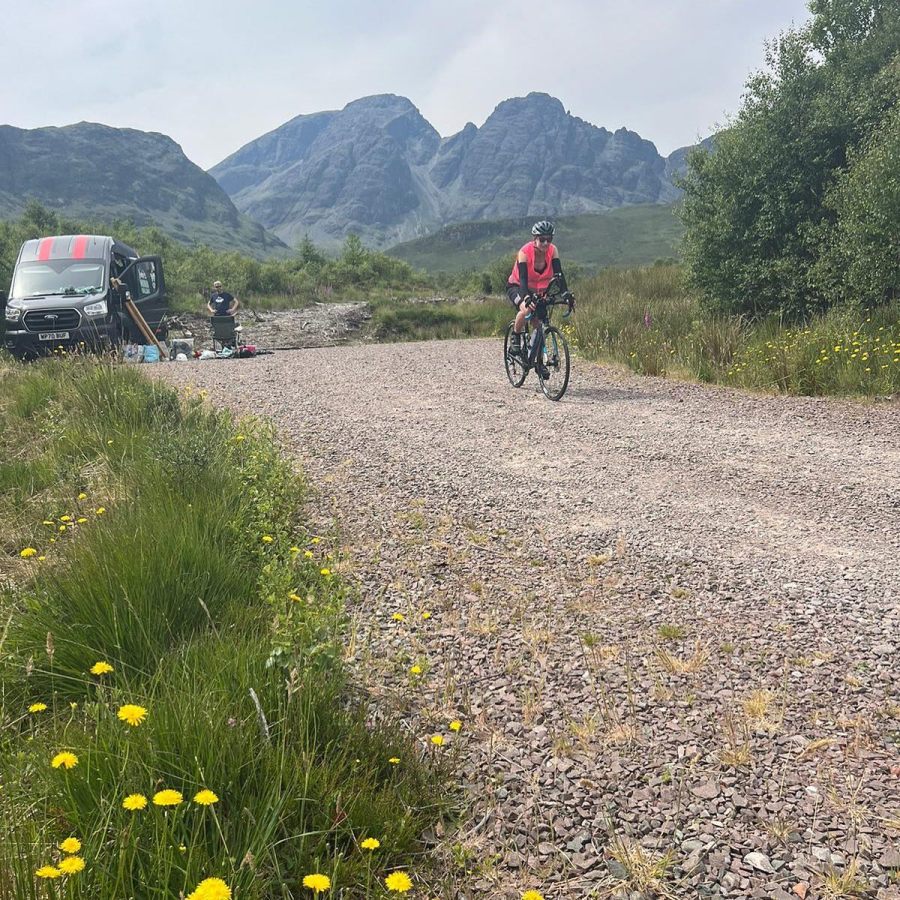
Biking away from Blà Bheinn with 83 Munros to go. Credit: Jamie’s Munro Challenge.
On one occasion, I got less than three hours’ sleep in the better part of 60 hours so was forced to take a nap after the traverse of the Cuillin Ridge on Skye. I’m not trying to micro-nap when I’m alert. I take them at a point when I am literally falling asleep on my feet. Maybe you’ve experienced it driving? I just need to have my eyes closed, be horizontal in a safe position and without being a liability to others. I’m vaguely aware of sounds around me, like the wind or perhaps people talking. These sounds might infiltrate to some degree but when I’m taking these quick naps on mountains, I’m not just lying on the ground with my eyes closed. I manage to fall asleep and reset.
TGO: Were there any moments during those 30 days when you thought you might not be able to get up and finish the round?
Jamie Aarons: I definitely didn’t think I was on for the record throughout. Although my moments of doubt were greater in the first few weeks, as my left foot got worse, I really didn’t know I had it for sure until the last day. Other people seemed more assured of my ability to keep going and get the record than I was and I think that reflects that fact that only you know how much pain you’re in and what’s that’s doing to you physically and mentally.
The drain of significant and chronic pain can’t be underestimated. I really, really sympathise with those who experience chronic pain. As people were waking me up from naps, the sleep deprivation wasn’t the only think that made me struggle to get up; it was knowing that the second my foot hit the ground it was going to be agony.
TGO: In those moments when you were in the ‘pain cave’, what pulled you out?
Jamie Aarons: I knew there was no way of fixing that pain besides finishing. That was my motivation. I kept telling myself that once this was over I didn’t have to put shoes on again! My race mantra is: “Would I quit if I was winning?” If the answer to that question is no, I’ll keep going. I’ll keep putting one foot in front of the other. It might be painful or slower than I wanted it to be but I’m capable of it. I’ve DNF’d in a couple of races when I’d answered yes because I was going to create a longterm injury. I had Rhabdomyolysis in a race in Italy once that could’ve had fatal consequences and I won’t push myself over that brink into stupidity.
My race mantra is: “Would I quit if I was winning?”
For me, this was partly about seeing what I could do and about pushing myself and my team and creating this army of support and seeing what we could achieve together. Indeed, there was pressure – not from the other team members but pressure I’d put on myself – and a sense of responsibility. I’d got all of these lovely people to rally around this selfish goal and I didn’t want to let them down.
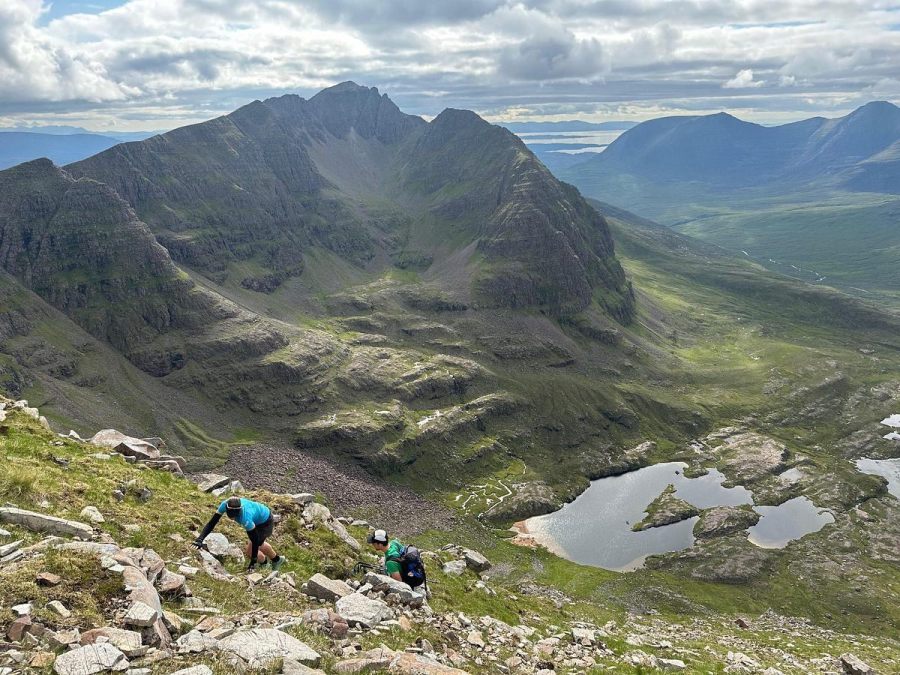
Jamie climbs Ruadh-stac Mòr (Beinn Eighe). Munro 250/282. Credit: Jamie’s Munro Challenge.
I didn’t switch my phone on the whole time – in fact I may be one of the last humans without a smartphone and Nic Crossley created the social media presence and collated photos I now have as memories. But I’d hear from my team about the sheer number of people watching my dot and supporting. It was overwhelming, intimidating and motivating all at the same time. Despite it being surreal, I tried to channel the nuggets of information from the real world and use those to fuel me. People were coming to say that they were inspired by what we were doing. That filled me with pride and I couldn’t let them down if I was capable of overriding the pain and finishing.
Also, my amazing crew were exceptionally good at falling into a cadence and gait I could sustain. Often when I was in pain or needed to zone out, I’d dip my head down and follow the feet of the person in front. I would visualise a string connecting my feet to theirs so that every time they took a step forward, it felt like they were pulling mine with theirs. You play these little mind games with yourself.
TGO: What of the highs? You seemed to be constantly smiling!
Jamie Aarons: I’ll never forget the moment a professional photographer doing my senior yearbook portrait – in which you’re supposed to look as though you’re staring off into your future – told me I looked like I’d never stop smiling. I don’t! I’m a smiley person. Physiologically, even when it feel unnatural, smiling releases endorphins so there’s merit in forcing a smile sometimes! But there were so many highs – and so many lows. It’s surreal that it’s compressed into a 31 day period.

A cloud inversion below the summit of Ben More Assynt. Credit: Jamie’s Munro Challenge.
I’ll remember the people and the landscape as particular highs. We saw cloud inversions, some amazing sunsets and moonrises. When we saw a a Strawberry moon I actually thought I was delusional! I’d never seen a sundog before and we saw a number of Broken Spectres.
Interestingly, my lowest points were almost immediately followed by the highest highs. At one time, my friend Elizabeth and I had to hunker down in the group shelter during the lightning storms for an hour and a half just as we were about to go up Beinn na Lap. We’d been seeing them in the distance but knew we didn’t have a choice but to stop. We were soaked. I managed to get a little sleep but it was disappointing and frustrating and uncertain as to next steps due to thing outside my control. About an hour later we were met with a double end-to-end rainbow. We were awestruck by such beauty.
I cried a lot during the rounds. Bar one time in particular when I had a bit of a sob because my foot was so sore, every time I cried I was crying tears of joy and gratitude. People took so much time out of their lives, arranged childcare, taking annual leave, driving for miles and miles to find me, tramping through tough terrain. When I think about it, I get a bit teary.
TGO: The round must have been a huge logistical challenge managed by you and your crew. Can you tell us about them?
Jamie Aarons: There are so many people I’m grateful to both who came out with me in the hills but also those who worked behind the scenes to route plan, amend schedules, and make sure all the kit was in the right place at the right time. We had a couple of stalkers who helped us and even Scottish and Southern Energy were exceptionally kind in giving support vehicles and crew access. I will never get to meet some of those people and yet they are all instrumental in this round.
Project Manager extraordinaire, Jenny Allen is a good friend of mine, a supporter and indeed an enabler and initiator of silly ideas! She’s the most humble person you will ever meet – she’ll be mortified I’m singing her praises in this way. Jenny was one of the first people I mentioned I was considering the Munro round. She created what became a behemoth of a spreadsheet. The round wouldn’t have happened and it certainly would not have been record-breaking if it were not for Jenny and she did it all while working full time for Cairngorms National Park. I suspect she got as little sleep as I did on quite a few nights! She was a constant source of reassurance. I saw seamless transitions and her efforts meant that I was almost always on a summit with at least one other person which was so special.
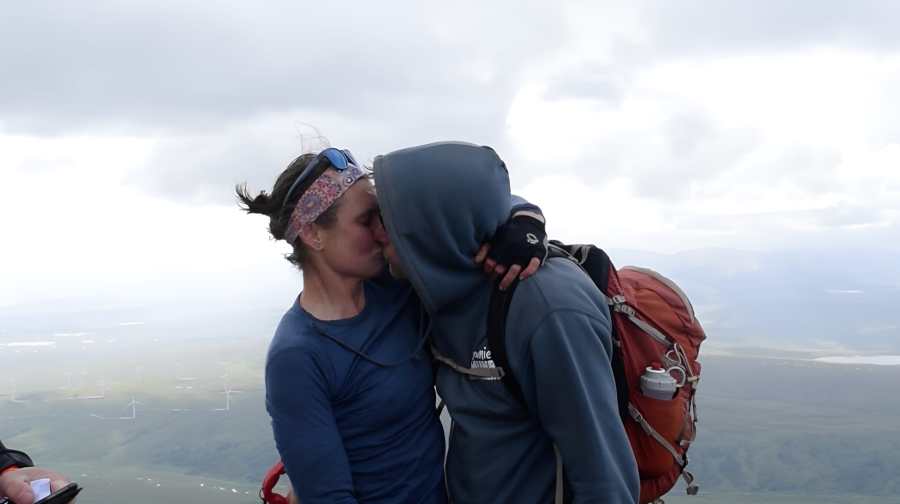
Jamie and Andy. Credit: Jamie’s Munro Challenge.
My gratitude for her is bottomless, as it is for Andy Taylor, my partner. He surprised me by working extra shifts and juggling his work to get unpaid leave and take all the time off to drive the support vehicle so he could be with me from start to finish. His presence increased my chances of finishing exponentially. His ability to anticipate my needs is freaky! On transitions, he was packing packs, refilling bottles, ensuring I had the right nutrition, dealing with my feet, doing bike and van maintenance, keeping things charged. He also set up a couple of mid-camps for us as well, gave me weather information and stats updates. I’m sure there were times, like Jenny, when he was stressed out of his head but what I saw was cool, calm, collected, supportive and unshakeable. The influence on my mental state can’t be understated.
TGO: You completed five kayak sections to Donnie’s two. What inspired you to take to the water in the kayak on this self-propelled mission and what new perspectives did that bring?
Jamie Aarons: Descending off the last Munro on Knoydart took us through incredibly challenging terrain. We were bashing through heather, bracken and fell into holes up to our armpits, sliding down wet crag. It was ugly. I’m still in shock neither of us were injured. It had taken us hours longer than expected. My estimated stats were mind-blowingly off, it was frustrating and we were both pretty broken.
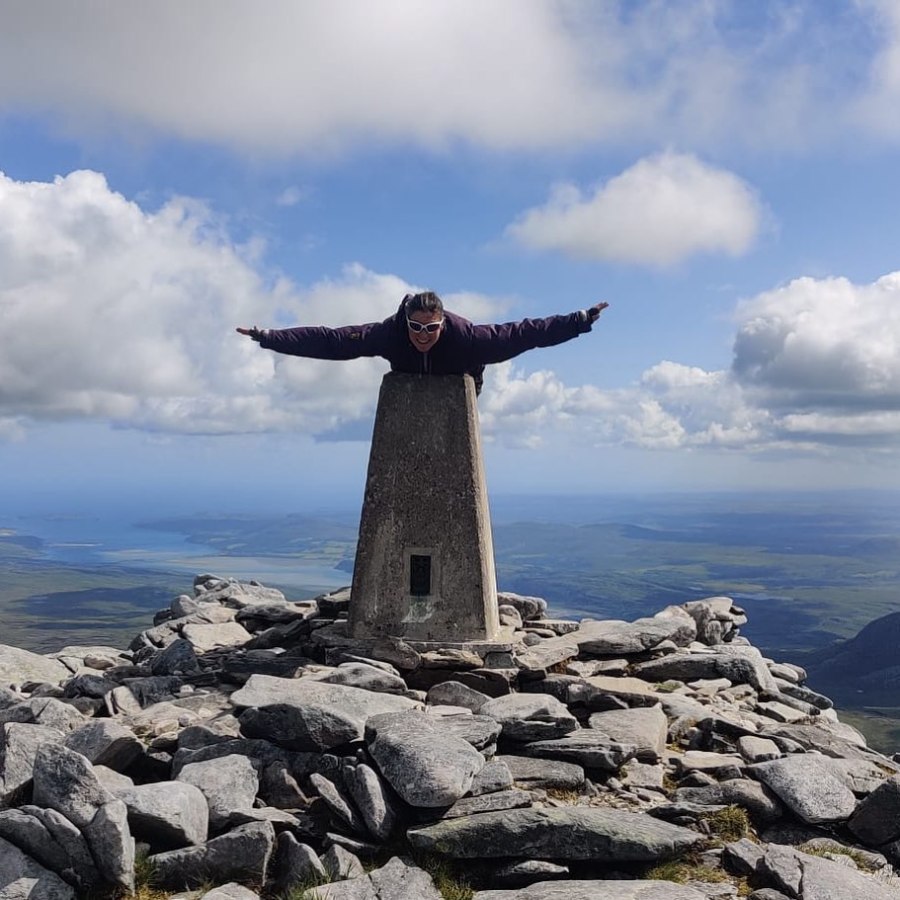
Flying high on Ben Hope. Credit: Jamie’s Munro Challenge.
And yet, I got to the shore and the kayak was there and waiting for me. I was paddling across Loch Hourn on my own. It was about midnight. Dark, but enough light that you could see the profile of the mountains, the silhouette of Beinn Sgritheall, and the water was absolutely flat calm. For whatever reason, the midgies decided to stay on the shore where they’d be absolutely horrendous. I turned my head torch off and could see the lights of the people waiting for me on the other side. I was probably about a kilometre away and I could smell the pizza Andy was cooking in our donated Oonie oven. It was a peaceful, calm reset.
I love paddling – some might say I chose the wrong challenge as these were my favourite parts. It was magical. I loved every single paddle stroke.
TGO: Can you tell us about what cycling has come to mean to you and why it was important to you to raise money for World Bike Relief?
Jamie Aarons: I like to think I’m quite environmentally conscious. I used to commute by bike in New York and Glasgow so cycling for me has been a means of transport, a means of spending time with Andy on our mountain bikes. I was overwhelmed with trying to choose between all the worthy causes out there and I genuinely lost sleep over the decision, which is amazing because despite what the challenge suggests, I like my sleep!
I wanted to support a mission that I felt could motivate me when the going got tough. There was this alignment with the amounts of miles I was doing on the bike. I liked the ethos of empowerment that World Bike Relief has at it core. As a social worker, the idea of prevention is incredibly important to our profession but perhaps it sometimes get lost in the day-to-day and fe find ourselves becoming more reactive. I liked the idea of being able to contribute something that felt positive in nature.
TGO: How are you celebrating? And where do you go from here? A fourth round?
Jamie Aarons: We were so lucky to be joined by so many people on the final summit and we did celebrate up there after I’d reach it bringing up the rear – unfortunately I still had to make my way down! And I do like a party. We celebrated that night at The Crask Inn in the shadow of Ben Klibreck, too.
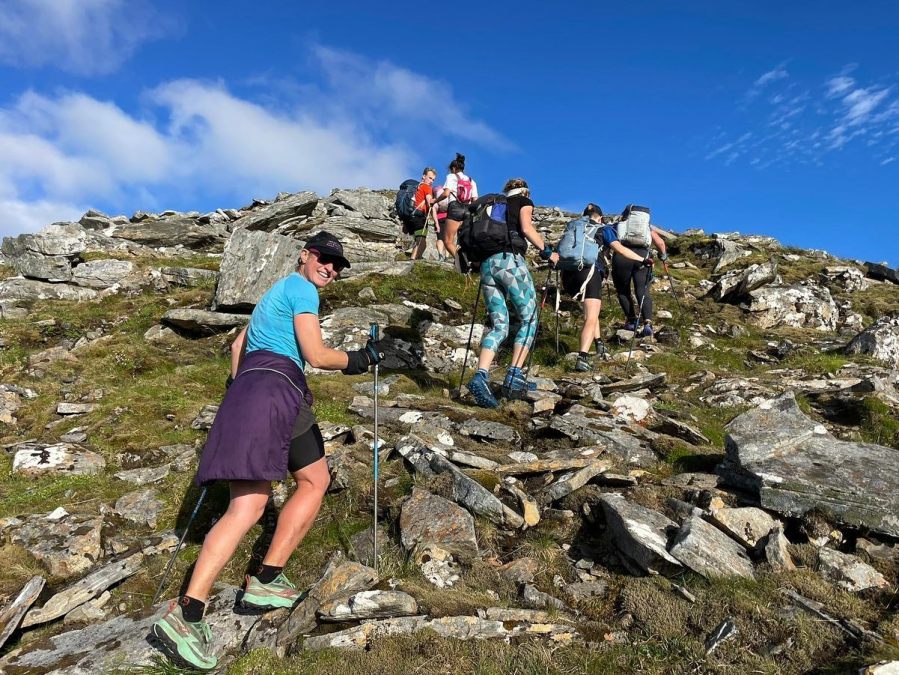
Sgùrr Mòr in the Fannichs with 14 to go. Credit: Jamie’s Munro Challenge.
People are struggling to let go of the WhatsApp group, I think. We’re hanging on to each other for as long as possible! What’s been so amazing is to see people for longterm friendships out of this silly idea. I will try and formalise my gratitude for the volunteers in the coming months, for sure.
My foreseeable future is going to be devoted to supporting all of the other silly ideas that come my way from other people. I get to join Jenny on some of her silly ideas. My friend Alex – the poor person who bore the brunt of my ‘sobfest’ in Fisherfield and took it like a champ – has events lined up. I’m supporting another friend Elsbeth on her Bob Graham round. Basically, now is the time to come to me and ask for support on your next challenge and I’m pretty sure I’m not allowed to say no! I also have a lot of baking to do to repay all of the baked goods my friends contributed to my Munro round.
The experience was so much more than a record. I want to spend the coming weeks writing about my memories and ensuring they don’t become a blur. I want to be able to look back on this month and recall everything with the vividness that I can now. I don’t want to forget the things that, in some respects, already feel like a lifetime ago.
You can follow Jamie as she supports those challenges on Instagram @jamieaaruns.

